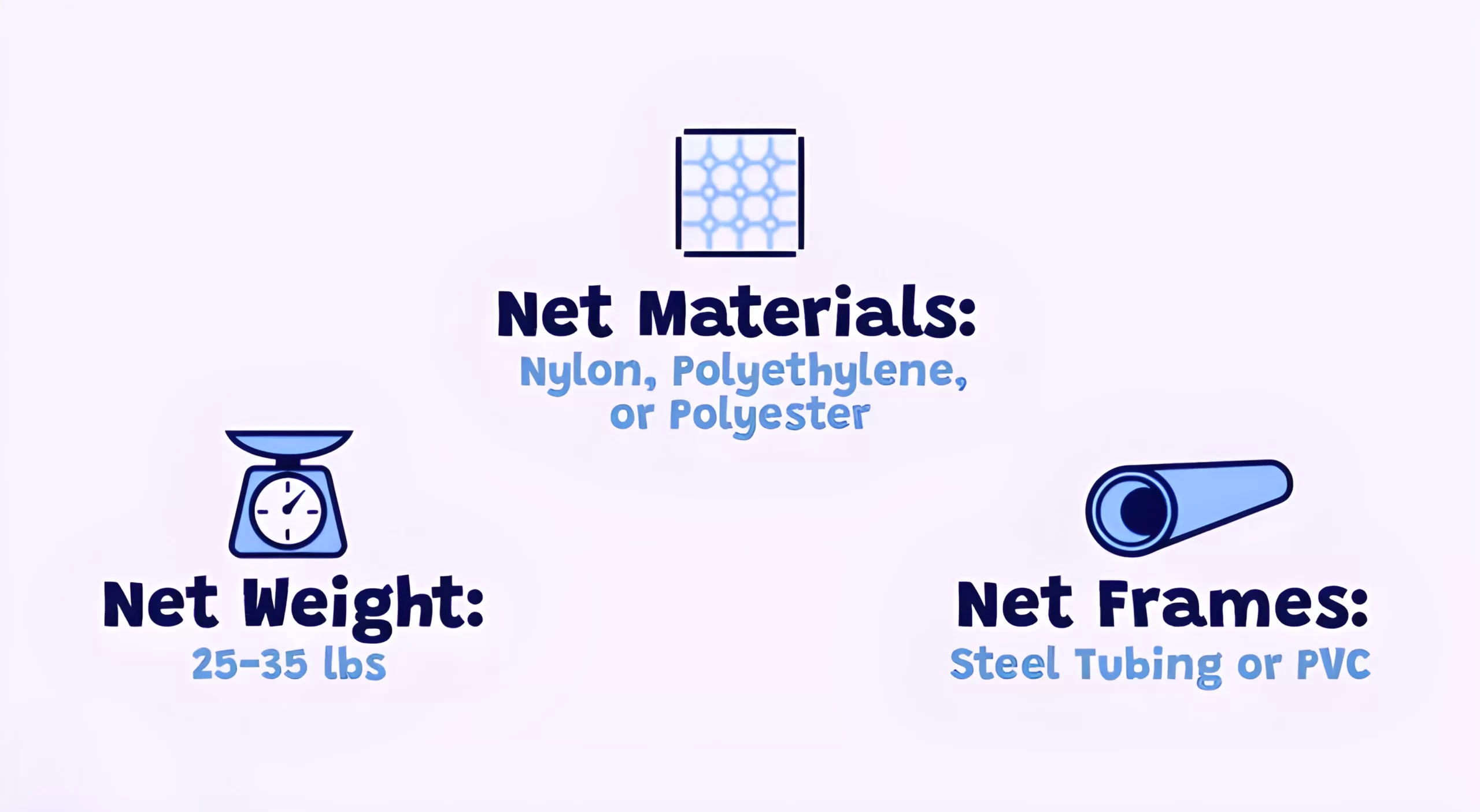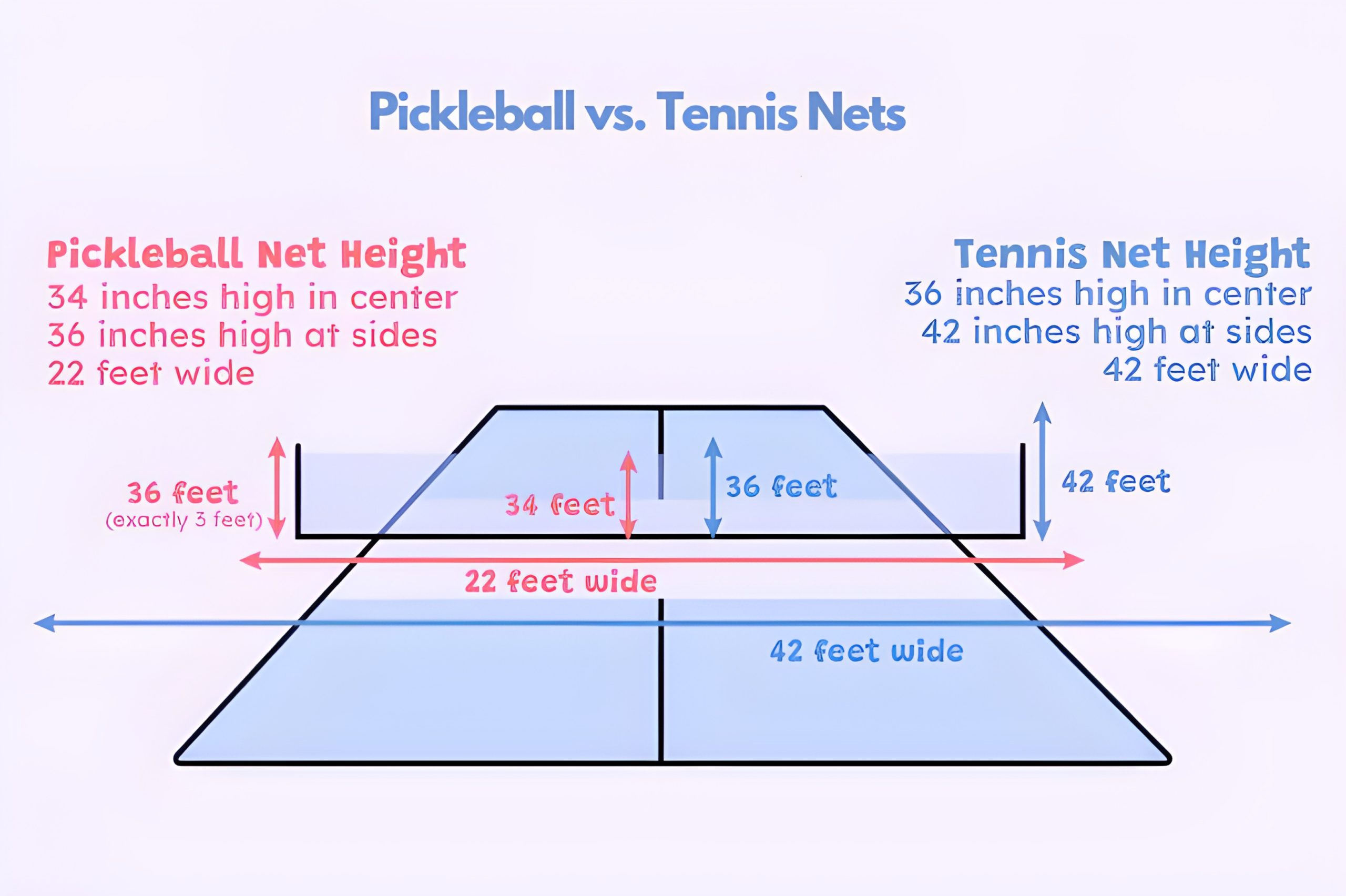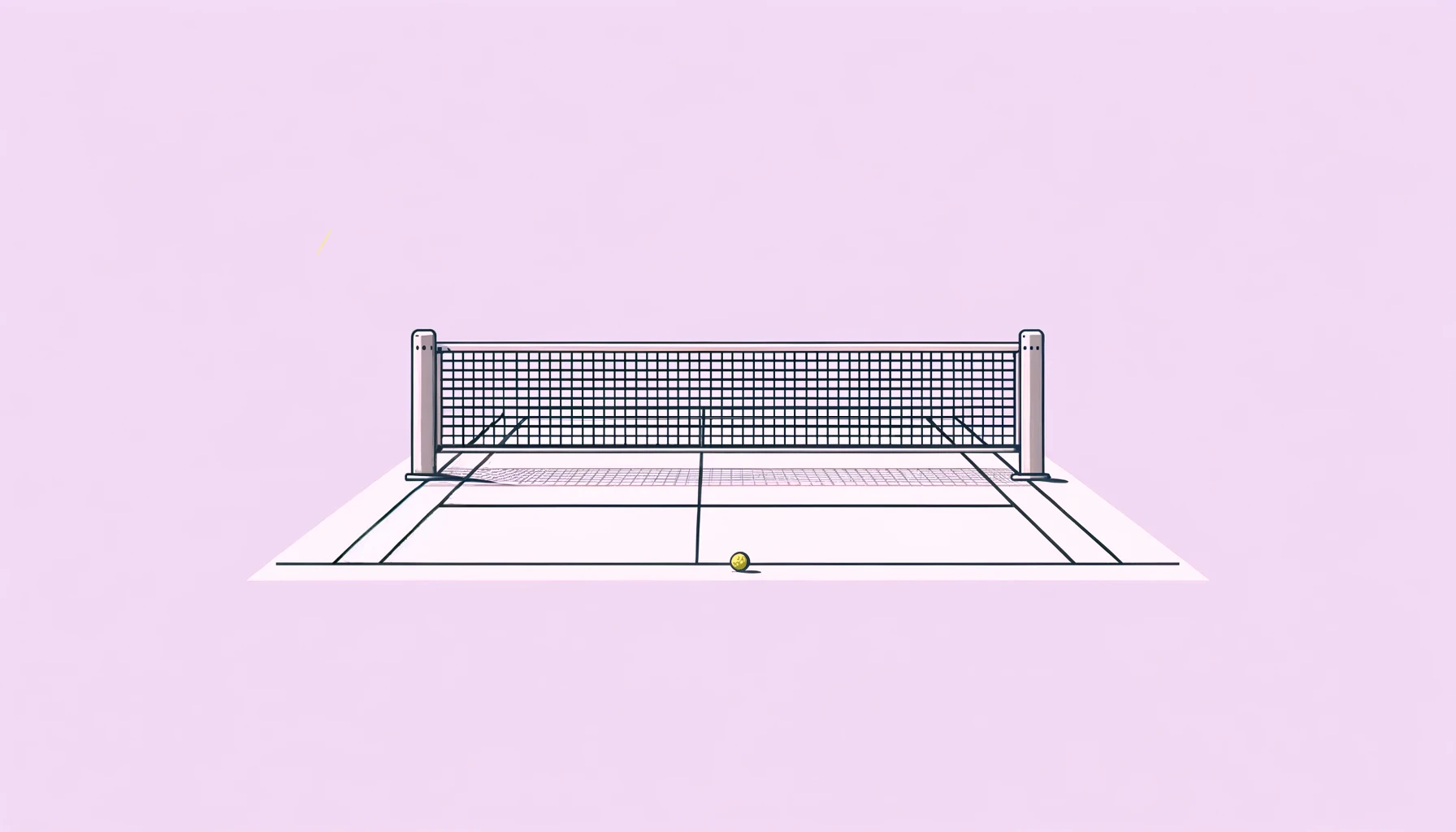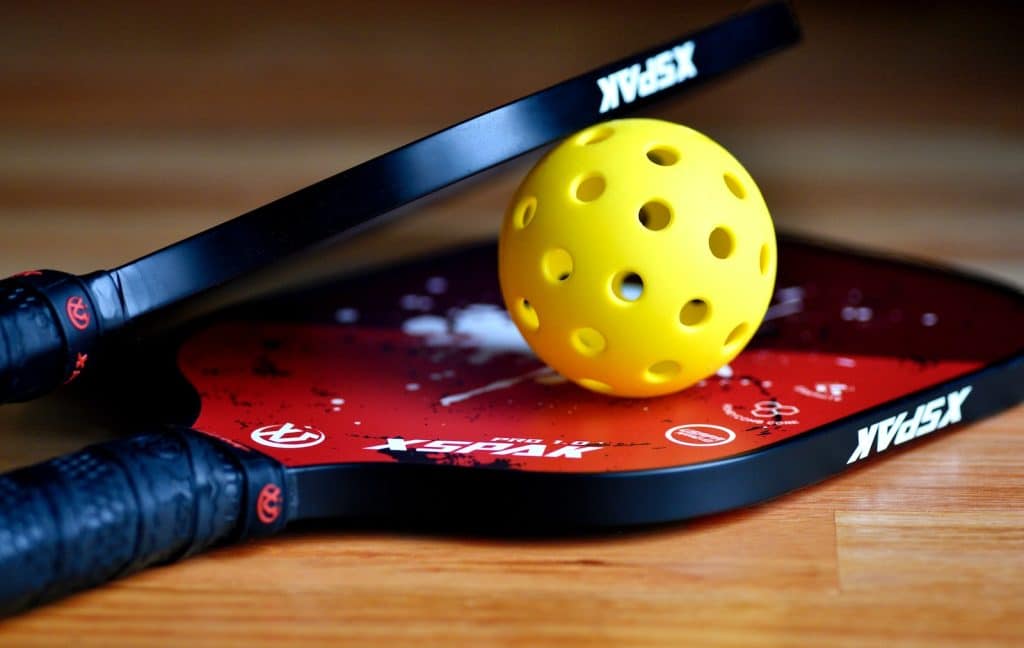The official height of a pickleball net is 34 inches at the center and 36 inches at the ends. This lower net height compared to tennis allows for various strategic shots and encourages a faster pace of play.
Pickleball incorporates elements of tennis, badminton, and table tennis. Central to the game is the pickleball net, defining the playing field. Similarly, tennis revolves around the tennis net, setting boundaries for players. This article will compare pickleball and tennis nets, highlighting their specifications and significance in gameplay and strategy.
The height and dimensions of these nets are meticulously designed to balance challenge, skill, and enjoyment. Adhering to the official net heights is vital in both sports for fair play and optimal enjoyment.
Table of Contents
Pickleball Net Specifications

Let’s talk about pickleball net specifications: We’ll cover everything from the essential height to the overall size, crucial for playing the game right.
Height and Regulation Size
The correct pickleball net height is precisely set at 34 inches at the center and 36 inches at the ends. This specific measurement ensures a consistent playing experience across different courts and is a standard observed in regulation pickleball courts globally.
Besides the pickleball net height, its overall size and dimensions are equally crucial. A standard pickleball net measures approximately 22 feet in width, covering the width of the singles and doubles pickleball court.
This size is essential to maintain the integrity of the game, as the pickleball net width directly impacts gameplay and player strategies. By adhering to these dimensions, players can experience the game as intended, ensuring fairness and competitive balance in both casual and professional settings.
Materials and Construction

Pickleball nets are commonly made from resilient nylon, polyester, or vinyl. Nylon offers affordability and durability, while polyester resists weathering. Vinyl binding boosts strength and longevity.
The net frame, typically aluminum or steel, enables stability and easy assembly. Its design maintains proper height and tension, keeping the net taut during play per pickleball standards.
Weight and Portability
Standard pickleball nets weigh 20 to 30 pounds. This strikes a balance between sturdiness to withstand play and lightness for portability. The weight facilitates moving and setting up the net, beneficial for those who use different courts or travel.
When selecting a portable net, consider collapsible frames, carrying bags, and easy assembly/disassembly via user-friendly locks and instructions, in addition to weight. Durability is also key, as packing and unpacking put wear and tear on portable nets. The net should maintain regulation height and size when set up.
Tennis Net Specifications
Now, let’s dive into tennis net specifications: Understand how they’re different in terms of size and height compared to pickleball nets.
Height and Regulation Size
While similar in many respects, the height of a tennis net differs from that of a pickleball net. The official tennis net height is set at 3.5 feet (42 inches) at the posts and 3 feet (36 inches) at the center. This variation in height, compared to the pickleball net height, impacts the game’s dynamics, influencing player strategies and shot selection.
Understanding these height differences is crucial, especially when considering the question, “are pickleball and tennis nets the same height?” The answer is a definitive no, highlighting the sport-specific nature of these equipment standards.
The regulation size and dimensions of a tennis net are also distinct. A standard tennis net spans the entire width of the tennis court, measuring 42 feet in width. This wider span compared to a pickleball net accommodates the larger court size used in tennis. The correct sizing of the net is essential for maintaining the integrity of the game and ensuring that official tennis court standards are met.
Materials and Construction
High-quality tennis nets often use heavy-duty polyester and braided cords for durability and weather resistance. A vinyl-coated top cable adds strength to keep the net taut.
Weight and durability are key considerations, especially for permanent outdoor nets. Heavier nets from 40-60 pounds ensure longevity despite frequent use and weathering. Material choices greatly impact lifespan – critical for facilities striving to provide quality tennis experiences.
Pickleball vs. Tennis Nets

Time for a side-by-side comparison: We’ll explore how pickleball and tennis nets vary in design and how these differences impact each sport.
Similarities in Design and Function
Despite their differences, pickleball nets and tennis nets share several key features and serve similar purposes. Both are central to their respective games, acting as the dividing line between opponents and playing a pivotal role in scoring and gameplay.
The basic structure of both nets — consisting of a mesh suspended by a cord and attached to posts on either side — is fundamentally similar. This similarity in design ensures that both sports maintain a consistent element of challenge and skill, where the net acts as a barrier that players must strategically navigate.
Differences
The main difference lies in net height – pickleball nets are lower. This affects strategies and pace, allowing more shot variety and faster play in pickleball versus more lobbed shots in tennis.
Nets also differ in materials and design to optimize each sport’s needs. Pickleball emphasizes lightweight portability, while tennis focuses on durability for permanent installations and rigorous play.
Historical Context
Initially improvising with badminton or tennis nets, pickleball standards evolved as the sport grew. Advancements enhancing durability and playability, similarly shaped tennis net specifications over time. This demonstrates sports equipment’s adaptive nature to meet evolving popularity and demands.
Adaptability and Interchangeability
Can tennis nets double up for pickleball? Let’s discuss the adaptability and necessary changes, and how they impact the game.
Using Tennis Nets
Using tennis nets for pickleball is possible but requires height adjustment to meet pickleball standards. The different tension and structure could also alter gameplay dynamics. While tennis nets can work temporarily, dedicated pickleball nets are best for an authentic experience.
The Center Height
The lower 34-inch pickleball net height allows for more shot variety like groundstrokes and dinks, enabling strategic, placement-focused play. Conversely, tennis’s 36-inch height demands high lob shots. This small but impactful difference changes shot selection and exemplifies how equipment standards shape the sports’ nature.
Selection and Maintenance Guidelines
Let’s get the best tips on selecting the perfect net for pickleball or tennis courts and how to keep it in top condition.
Choosing the Right Net
Selecting the right net for either pickleball or tennis involves considering several key factors. For pickleball nets, portability, ease of setup, and compliance with regulation pickleball court dimensions are crucial. Players should ensure the net meets the pickleball net height and width requirements for official play.
In tennis, the focus shifts to durability and weather resistance, especially for nets in permanent outdoor installations. The tennis net should conform to official tennis court specifications, including the correct height and width.
Recreational players can opt for budget-friendly portable nets, facilitating casual play. Competitive players should invest in higher-quality regulation nets. Indoor versus outdoor court conditions also impact material selections.
Maintenance
Regular care like checking for damage, debris, and wear extends net lifespans. Properly storing nets when not in use also helps longevity. Adjusting tension prevents the pickleball net from sagging. Assessing tennis net cables, cords, and metal parts for rust maintains good working order. Simple, diligent care enhances play and longevity.
Sign-Off on Nets: A Parting Shot
While sharing fundamental similarities in design, pickleball and tennis nets differ notably in height and materials to optimize their respective sports. The lower pickleball net promotes a dynamic, faster-paced game, while the higher tennis net facilitates lob shots and longer rallies. Their specialized construction balances each sport’s priorities – portability versus durability.
Using regulation nets is vital to maintain gameplay integrity and enjoyment. Adhering to the precise pickleball and tennis net specifications ensures the sports are played as intended across all player skill levels. Given the central role nets play in defining these sports’ boundaries and challenges, respecting net equipment standards enhances safety, fairness, and quality of play for all.



